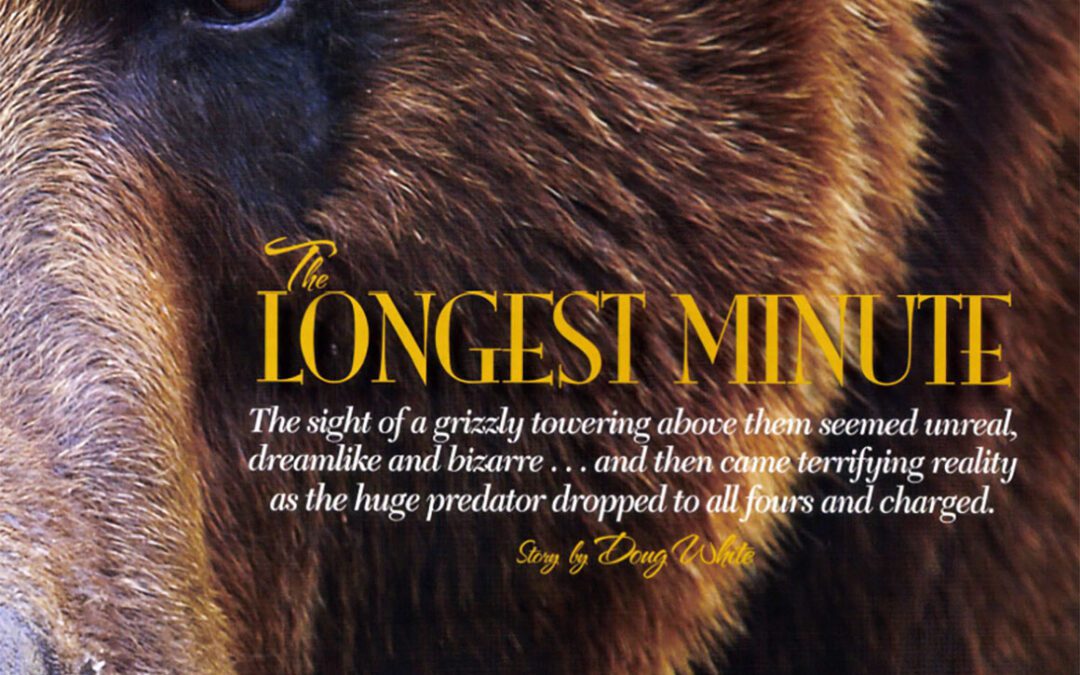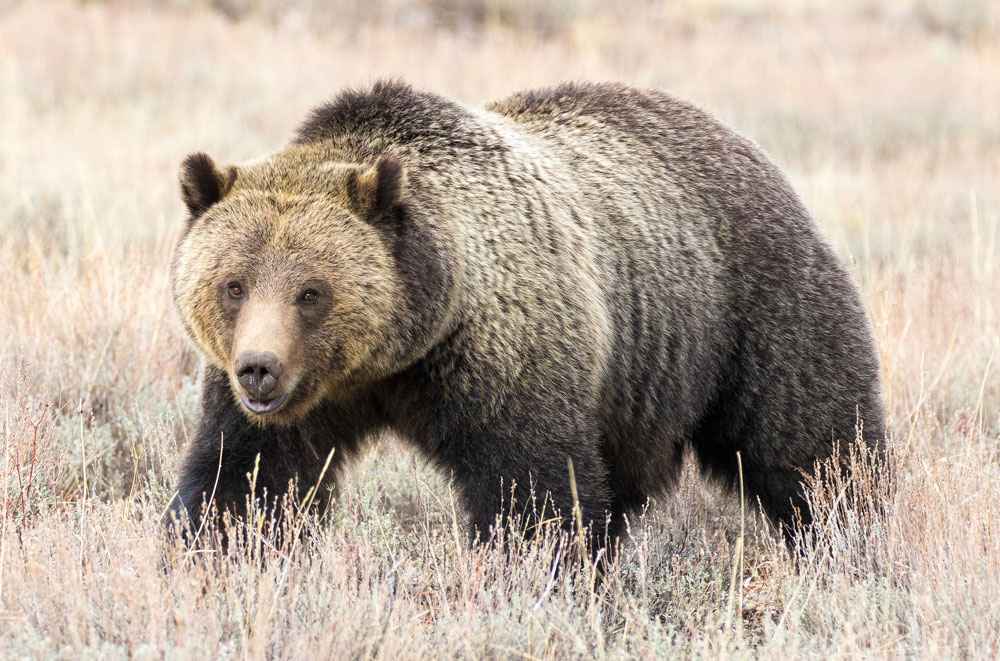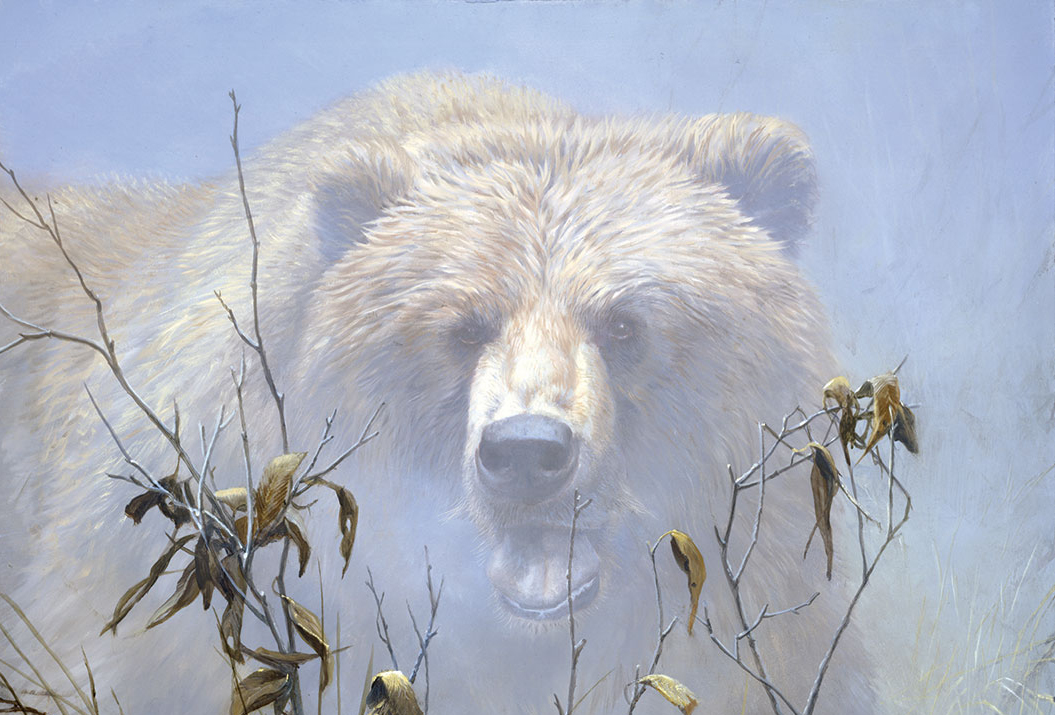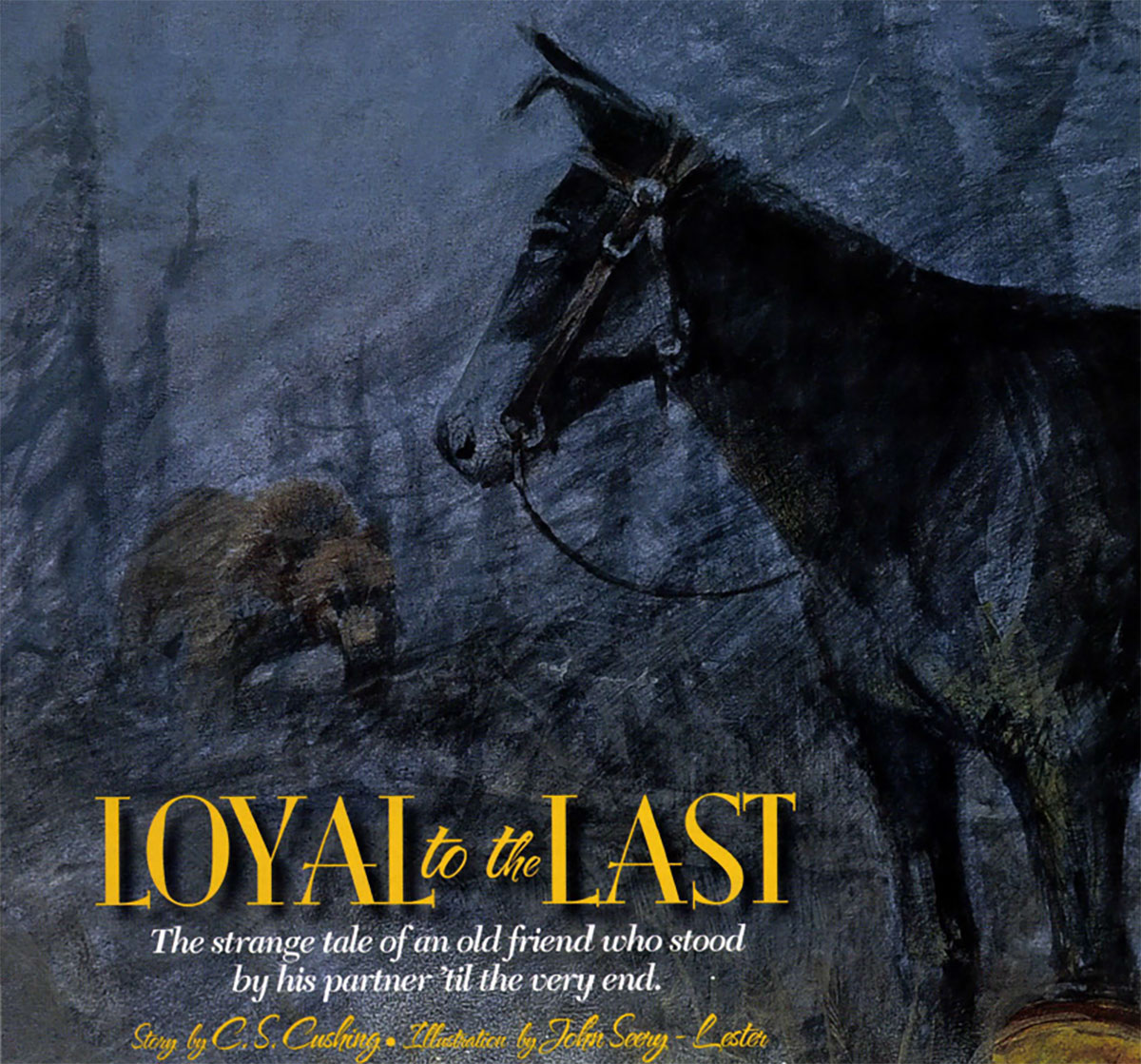I stood up and grabbed the holster but was unable to remove the revolver regardless of how hard I tugged. When I looked up, the grizzly was charging toward me…The next minute seemed to last an eternity.
Most of us are familiar with the movies, The Longest Day, The Longest Yard or The Longest Mile. Well, I am going to tell you about “The Longest Minute” of my life. Reed Thompson and I had been hunting hard for five days. The day was Thursday, September7, 2006. The weather had turned from beautiful sunny skies to gale-force winds and the blasting rain that comes with autumn storms in Alaska. Never has the weather dictated our hunting time, so we packed our gear and ventured into the bush.
After several days of not seeing a single bull moose, we left our base camp several miles above Portage Creek on the Nushagak River and moved to an area downstream that had always been productive. We were anticipating a great hunt, but just experiencing the unspoiled wilds of Alaska was priceless.
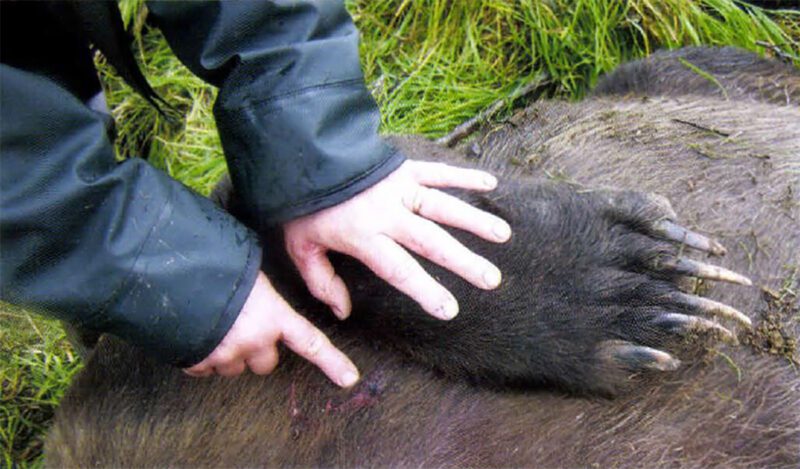 Eight years earlier, Reed arrived in Dillingham for a site visit. He was applying for a position as a Staff Dental Officer at the Kanakanak Hospital. After taking him for a boat-ride on Lake Aleknagik, I knew he was hooked when I saw his saucer-sized eyes observing the majesty of the water and mountains. Since that time, we have survived many Alaska adventures together. I moved to Dillingham in August 1997, expecting to fulfill a two-year commitment as Chief Dental Officer of Bristol Bay Area Health Corporation. There must have been something in the water because now I’m addicted to bush Alaska.
Eight years earlier, Reed arrived in Dillingham for a site visit. He was applying for a position as a Staff Dental Officer at the Kanakanak Hospital. After taking him for a boat-ride on Lake Aleknagik, I knew he was hooked when I saw his saucer-sized eyes observing the majesty of the water and mountains. Since that time, we have survived many Alaska adventures together. I moved to Dillingham in August 1997, expecting to fulfill a two-year commitment as Chief Dental Officer of Bristol Bay Area Health Corporation. There must have been something in the water because now I’m addicted to bush Alaska.
Later in the afternoon, we were walking down a half-mile-long finger of ground that was slightly higher than the swampy tundra on either side. We had slogged across the swamp as quickly as possible during a sudden deluge to get to this downwind point. Our hope was that in the heavy rain any moose in the area would not spot us.
About halfway down the finger, Reed turned to me and said, “I think there’s a moose up ahead. See the two white sticks in the grass … It wouldn’t surprise me if that was a moose.” I glassed the tall grass and alders about 100 yards ahead. With Reed’s help, I zeroed in on the two white sticks and watched them for several minutes. With the slightest movement, the two sticks transformed into a white paddle and then back to the two sticks. The bull had moved his head ever so slightly.
I turned my scope to 10-power and began focusing on the antlers as Reed edged closer to the bull. When Reed had taken a few steps, I saw the horns rock back and forth. The big boy then stood up and looked in our direction. Even in the 40-mile-an-hour winds blowing directly at us, he had sensed our presence.
Shooting freehand, I squeezed off a round from my Browning .338 and felt good about the shot, but the bull took two or three steps to my light and disappeared behind some alders. Reed could still see him and shouted, “Do you want me to shoot him?” I yelled back to go ahead because I did not want the bull running too far. I heard his shot as I was scrambling forward to get a better look.
After running about 30 yards, I was able to see the bull and put another shot into him. He dropped instantly. Hesitant, but with great excitement, we approached the giant and realized he was dead. He had a beautiful rack and the largest body of any moose I’d ever seen. Now the fun was definitely over and the real work would begin.
Consulting our CPS, we noted that we were a half-mile from the slough and our boat. We decided to return to the boat, discard any unnecessary items, and return with the gear needed to prepare and pack out the meat. We placed red-and-blue handkerchiefs high in an alder bush so we could see the spot from a distance. The half-mile hike seemed fast and easy because we were so pumped up and excited beyond explanation.
We left our heavy rifles in the boat, then gathered up our pack frames, game bags, ropes and knives. After Reed repositioned the boat to compensate for the upcoming low tide, I asked him with hand signals if he remembered to bring the handguns. In the gusty winds and rain, he couldn’t understand my award-winning charade performance, but I let it pass after observing his revolver strapped to his chest.
We were hot, sweaty and wet by the time we got back to the moose. The downpour had abated for a while, so were moved our rain gear and hung it in a small tree about five yards away from the moose. Reed removed his revolver and hung it from its holster on a branch opposite his jacket.
With darkness approaching, we decided to remove the top front and rear quarters, tie them to our pack frames, gut him out, and then roll the carcass over to cool through the night. We would return in the morning to finish up.
After removing the two quarters, we began cutting and tearing away the internal organs. Darkness was settling in pretty fast and I could barely move my arms as I struggled to remove the heart and part of the esophagus. At this point, Reed said that he would trade places with me. I moved to a position behind the rear legs while Reed actually crawled up inside the gut cavity. A couple of cuts and the ordeal was over. As Reed pulled the heart out and tossed it behind us, a loud HUFF snapped us to our feet. Turning around, we saw a large, chocolate-brown grizzly standing before us on his hind legs.
The next minute seemed to last an eternity. The term surreal is so overused, but the ensuing block of time was dreamlike, bizarre, fantastic and unreal.
The bear was standing next to the tree where the pistol was hanging. We both started shouting and waving our arms as we stepped to our light toward the tail end of the moose. The bear came down off his back legs onto all fours and started circling to his right toward the head of the bull. My only thought was to get to the gun so I could scare him off. Just as I broke for the gun, the bear vaulted over the moose’s antlers and went straight for Reed.
Halfway to the tree, I tripped on a fallen log and went down on all fours. From my peripheral, I saw the bear going after Reed, who had moved into the 5-foot-tallgrass. It appeared the grizzly had knocked Reed down and was standing over him. My worst fear was that my friend was being mauled.
I stood up and grabbed the holster but was unable to remove the revolver regardless of how hard I tugged. When I looked up, the grizzly was charging toward me. I started backing up as I continued screaming and hollering at the bear. I was frustrated that the pistol would not break free from the holster.
With the bear almost on top of me, I tripped on a log and fell onto my back. As I raised my legs to kick him away, I felt him swat or grab my left leg about mid-thigh with his right paw. My rubber hip boots may have protected me from harm. As he straddled my legs, his huge head hovered above my lap, just out of reach of my holstered gun.
I tried to hit him with the pistol, but a crazy thought entered my mind — that I could scare him into thinking I was going to shoot by waving it back and forth. Still unable to remove the pistol from the holster, I tried to shoot through it, but the strap held the hammer down on the single-action revolver.
Just when I thought all was lost, the grizzly rose up, pivoted 90 degrees and charged back toward Reed who had jumped up and was yelling at the bear. Reed had seen the bear knock me down and it appeared as though I was being mauled. Now, with the bear coming at him once again, Reed figured he was toast. He was alone in the grass with no weapon, and I was down and most likely dead or badly injured.
When the grizzly started his charge, Reed dropped backdown into the low wallow area where he had fallen during the initial charge. In the darkness, Reed saw the bears face about a foot from his own. He could hear the bear trying to sniff him out. At that point, the bear stood up, turned and charged back to me.
While the bear was focused on Reed, I jumped up and had time to concentrate on the holster. I saw a buckle with a strap running through it. I couldn’t figure out how it held the gun in place, so I grabbed the buckle and tried to rip it off. To my surprise, the buckle was actually a snap and the strap peeled away.
As I pulled out the revolver, a sudden calm came over me and I knew everything would be fine. I looked toward Reed and saw the bear pushing toward me. He was about 10 feet away, coming up and over the log I’d just tripped over. It seemed like slow-motion as I raised my arm, thumbed back the hammer, pointed the revolver and squeezed the trigger, firing into the center of the bear’s huge mass. The .44 Magnum boomed in the night, sending a bolt of fire toward the boar. The 280-grain bullet smashed into his chest, killing him before his body slammed into the ground. His momentum carried him partially over the log, his head coming to rest three feet from where I stood. As he fell, the powerful jaws snapped shut, crushing a mouthful of tundra grass.
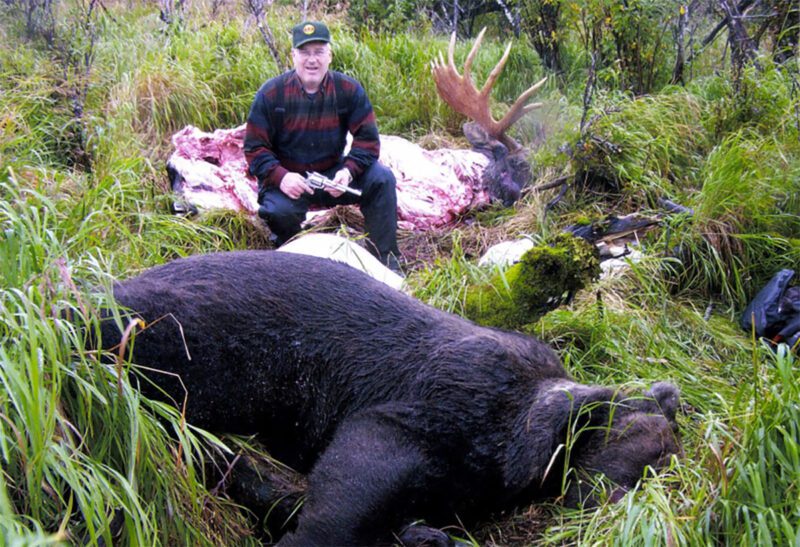
I stood in a dumbfounded stupor. I had no expectation the pistol would kill the bear. I only hoped the flame and loud report, along with the impact of the bullet, would scare him away. As the bear sagged to the ground, I shot him three more times in the head as quickly as I could thumb the hammer and pull the trigger primarily out of fear and anger. I still believe that the Lord’s hand had more to do with my shot placement than my meager pistol experience.
My next sensation was hearing Reed’s voice asking if the bear was dead. I responded with a “Yes.” He then yelled at me to save the rest of the rounds because we still had to walk out and he did not have any more bullets. with him. Our longest minute was over. We hugged each other for a long time before packing out the moose quarters.
Our trek through the darkness was filled with trepidation and deep thought. The tiny LED lamps strapped around our heads did not light up nearly enough area as we marched out of the island’s interior. It was like snorkeling in the ocean at night, unable to see anywhere except right in front of your eyes. It was one of the longest hikes I’ve ever taken.
Reaching the boat, we discovered the bear encounter had delayed us long enough to prohibit our departure. The motor was out of the water and, hard as we pushed, the boat would not budge. The two of us had the joy of spending the night on the bank in the worst storm of the year. Fortunately, we were prepared for such a possibility. Hunting on the lower Nushagak River necessitates dealing with 25-foot tidal swings.
After dumping some two gallons of gas on some branches and logs, we sat down next to a roaring fire that offered little heat through the rain. Our adrenaline rush exhausted, we mustered what little energy remained to assemble the two-man tent, spread out our sleeping bags, and lay down out of the rain. There was no sleep that night.
Our conversation that evening was obviously centered on the grizzly attack. We analyzed and reanalyzed everything we did and everything the bear did. We talked about what we did wrong and what the bear did wrong. We chatted about the bear’s actions and our own actions. We discussed the outcomes of every scenario thinkable. We finally concluded that the manner in which the attack occurred was extremely fortunate for us. It could not have played out better had all the actions been choreographed months in advance. The placement of the revolver in the tree, the way we spread out when the bear attacked, the timing of our falls, the screaming and yelling by one of us while the bear was involved with the other, the way the bear came over the log just as I shot, and the distance between each of us — all worked out for our survival, or at least the freedom from terrible pain.
Our incident occurred three days before bear season opened. We had to skin the bear, remove its head, pack it all out to the boat, and turn everything over to the Alaska Fish and Game Department. It was then that we learned a bear of the same size and coloration had raided two camps on the far side of the island the week before. He had taken at least a quarter of meat from one of the camps.
Many other questions come to mind that may never be answered. I am convinced that bear experts will mull over this incident looking for blame, as well as answers to many of the questions. Did the bear hear the dinner bell when the shooting took place? With the severe wind, did the bear smell the dead moose and start zeroing in on it? Was he startled into action when the last entrails were tossed in his direction? Why was he not fearful of us? Why did he attack? Why did he charge Reed first when I was the one moving toward the gun? Why was he distracted between the two of us? Why didn’t he put the hurt on each of us when he had us down? Would he have left us alone if we had feigned death? I do not have the answers and will not pretend to understand the encounter completely. I do know that we learned important lessons that will benefit us both in the future. Some victims of bear attacks do not survive to learn from their experiences.
Following are some of those lessons for anyone who hunts in bear country:
1) Yes, a bear can attack you. Many of us who live, hunt and subsist in Alaska have observed bears. Usually, they are seen running away as fast as their powerful legs can carry them. I have read information claiming that a grizzly bear can move 44 feet in one second. With that kind of speed, it does not take many seconds for a bear to move great distances away from or toward a hunter or hiker.
2) While field-dressing an animal, always have a weapon within arm’s reach. Fifteen feet away in a tree is much too far. An encounter can occur within seconds. Each hunter should have his or her own weapon, depending on personal preference, such as a long gun, a handgun or pepper spray.
3) Be familiar with all the weapons (and holsters) in your group. There may arise a situation when a companion’s weapon must be used. Practice with the weapons that will be available.
4) Do not get so involved with the task at hand that vigilance and alertness are forgotten. Keep all your senses on high alert; anticipate trouble.
5) Bears can be as varied as people. They grow up in different environments. They have diverse growing experiences, dissimilar personalities and can get moody in various situations. They have a huge desire to gorge themselves at various times of the year. Treat them with respect and give them a wide berth when possible. Bears are truly an awesome component of the miracle and beauty of nature. Beware, they have resided on top of the food chain for a very long time.
I wrote about my adventure because my grown children requested it. I placed the story on the hospital intranet, along with four pictures, so the staff could see and somewhat feel the experience. Prior to writing this Story, it seemed that every person who walked by the dental clinic stopped and asked about the bear incident. My workload did not allow me the time needed for re-telling the story. I was shocked at how fast it spread out of Dillingham and into cyber space. There were reports that the story had reached other countries.
Most people were amazed that we survived, while others scoffed at the truthfulness of my story. Some said that the pictures were altered, and yet others said we just killed the bear and made up the whole thing. Reports have found their way back to us stating that the moose had been shot to bait the bear. We had no thought of seeing a bear that night. What I have written is true. It was not an experience we went looking for, nor would it be an experience either one of us would like to relive. I do thank my Father in Heaven every night that both of us were able to walk away from the incident.
I have not had nightmares, nor do I jump at noises in the night, but I do think about the attack every day. I find myself trying to analyze why it happened and what we could have done differently. In trying to survive, did my mind shut down various sensations? I did not smell the awful stench others talk about. I do not remember any jaw or teeth popping. I do not remember hearing any growling or snorting. The first time the bear charged me, he was there in an instant. His head was down and angled to the light. When I toppled onto my back, I saw him snapping repeatedly in attempts to bite the holster as I swung it back and forth in his face, but I remember no sound.
I believe the reason bear tales are so captivating is that people share a primordial fear of the carnivore. It is a natural dread that resides deep in our human gene pool.
Many readers have inquired about the size of both animals. The moose’s rack measured 63 inches across. Best of all, a large portion of a freezer was filled with wonderful-tasting meat. The bear measured 9 feet 2 inches from left front paw to right front paw, and 8 feet from nose to rump. When standing on his rear legs, as we initially saw him, this bear presented more then 10 feet of spine-chilling terror. He was not starving, for he was stuffed full of blueberries.
I have developed a keen interest in reading about documented bear attacks. The more I read, the more I realize how extremely fortunate we were. From my story, I hope readers will glean some tidbits that will make their outdoor experiences fun, long-lasting and safe. Enjoy the awesome beauty of the outdoor world, but stay alert and be prepared. There is no greater joy than returning home to loved ones and sharing your adventures and splendors of the wild country.
Editor’s Note: This article originally appeared in the 2009 July/August issue of Sporting Classics.
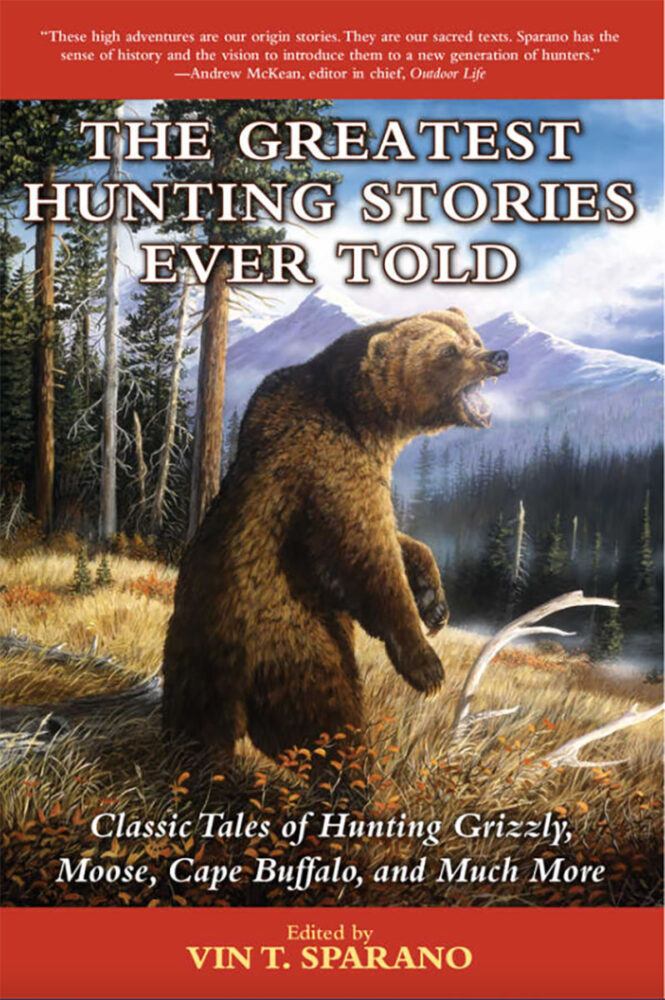 Now, for the forty million Americans who hunt, here is the perfect companion. The Greatest Hunting Stories Ever Told is a collection of true hunting tales, told by some of the most courageous and clever sportsmen. The quest for adventure has touched all these writers, who convey the drama, tension, stamina, and sheer thrill of tracking down game. Buy Now
Now, for the forty million Americans who hunt, here is the perfect companion. The Greatest Hunting Stories Ever Told is a collection of true hunting tales, told by some of the most courageous and clever sportsmen. The quest for adventure has touched all these writers, who convey the drama, tension, stamina, and sheer thrill of tracking down game. Buy Now
